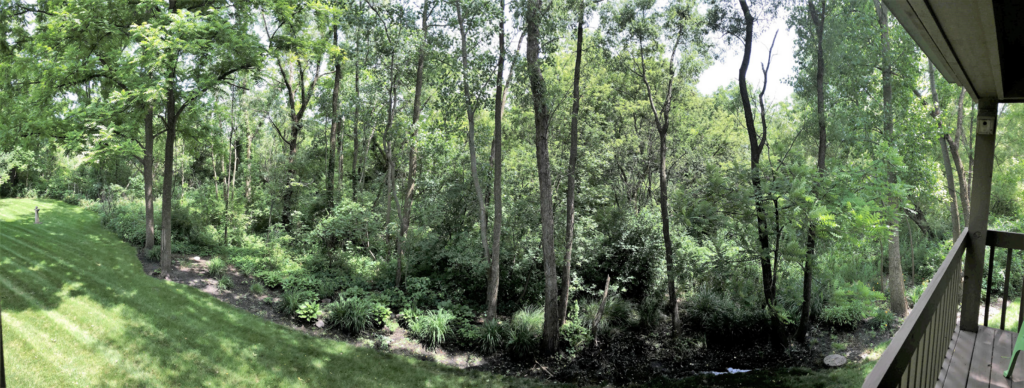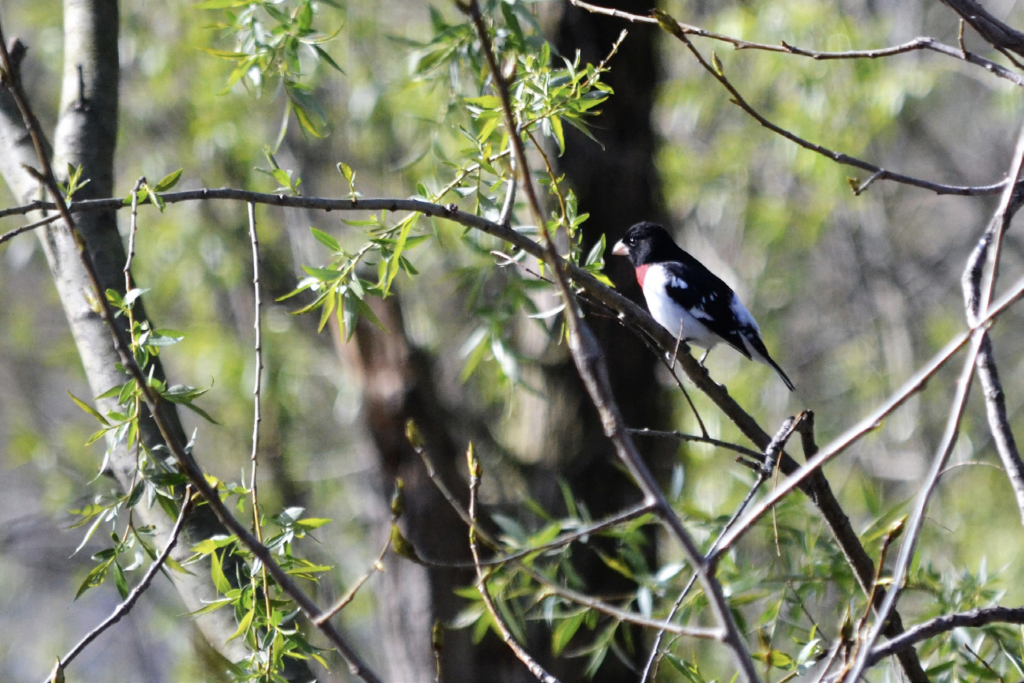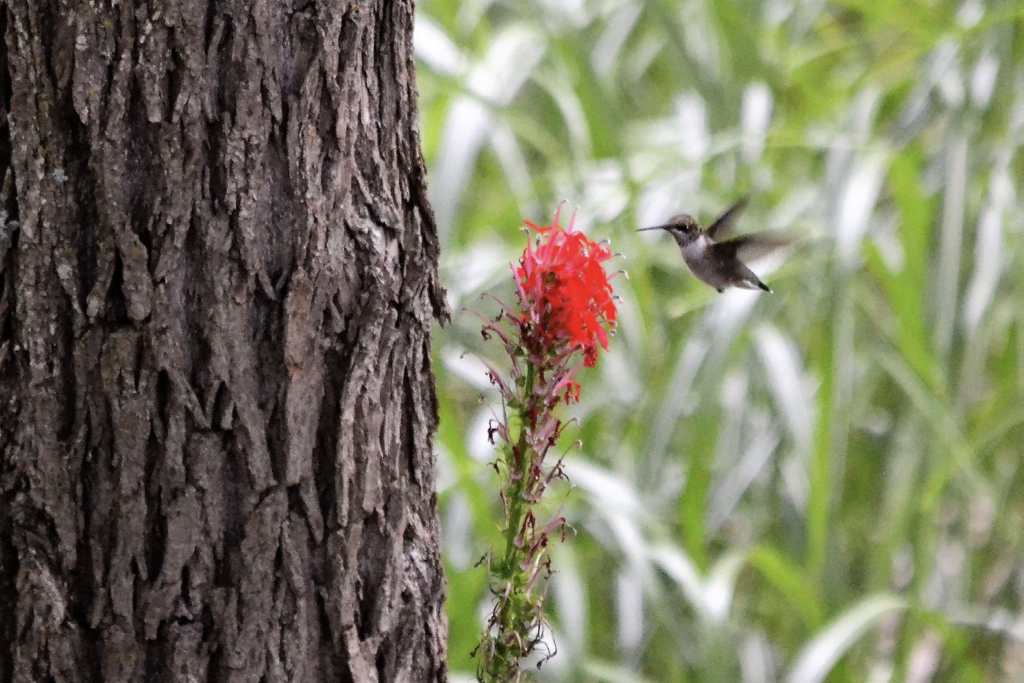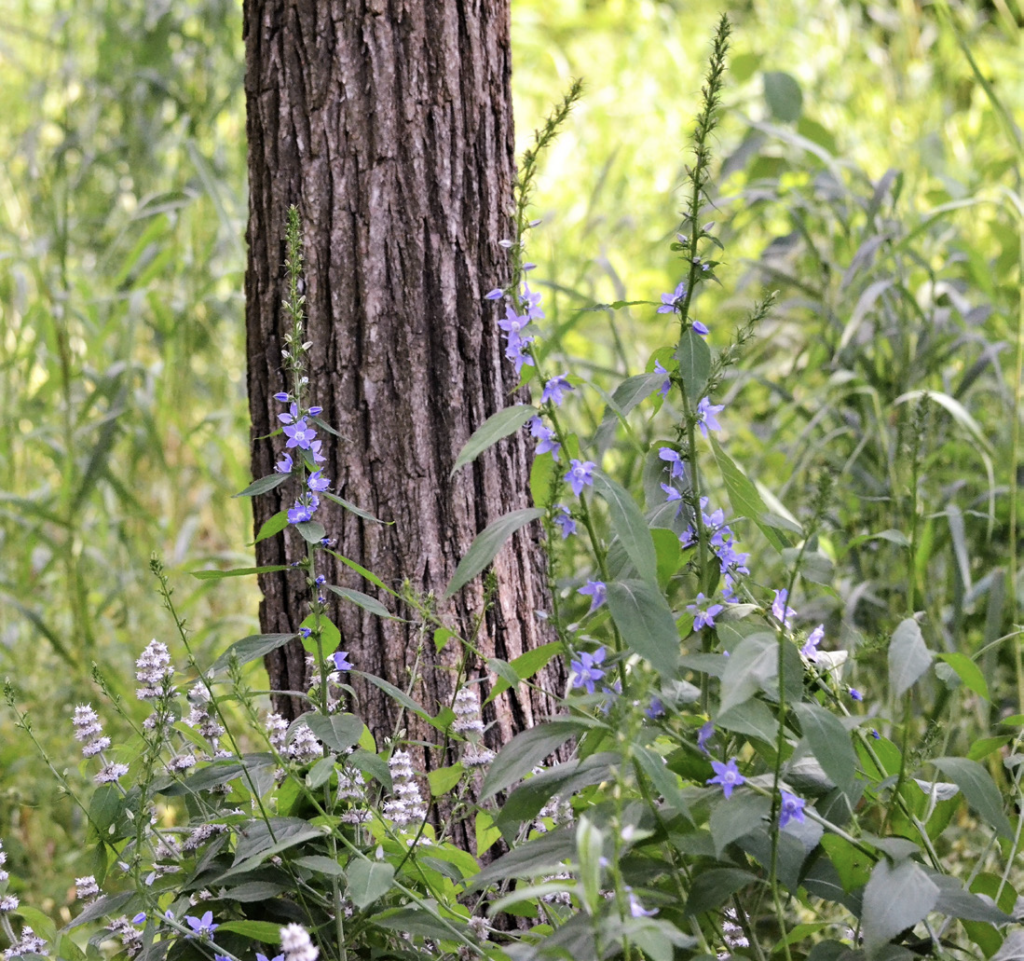Deb and Ray Rees are beginning to see the fruits of their labor in their third year of restoring a small floodplain woodland in Elgin, Illinois.
This is an excerpt from the Wild Ones Journal
Current members can log in to read the latest issue or check out the Journal Archives.
The couple bought the almost half-acre plot in 2017, primarily because it backed up to a natural area along a creek and contained many venerable shagbark hickories and white oaks in the subdivision.
At the time, the property had a 5-foot-wide bed of perennials on its border with the lawn backed by a wall of greenery consisting mainly of phragmites, reed canary grass, honeysuckle, buckthorn and privet underneath shagbark hickory, cottonwood, box elder, walnuts and black willow trees.
“In 2018 we realized that phragmites and honeysuckle were fast taking over this perennial bed and that it would be a big task to keep the floodplain plants out of the bed,” Deb said. “That’s when we came to the conclusion that native plants would be a better fit.”

They hired a professional to mitigate the phragmites and remove the woody invasives, such as honeysuckle, buckthorn, multiflora rose and privet, from the front of the floodplain.
“That was the best decision we ever made,” she said. “We returned from a weekend away to see that they had serendipitously cleared the entire area behind our home back to the creek.”
The area was transformed into an open floodplain woodland with an overstory of black willow, cottonwood, box elder, walnut and shagbark hickory trees and an understory of dogwood and elderberry.
“This initial clearing of the ‘wall of green’ encouraged us to set our sights on one, keeping it clear of invasives and two, restoring it to its former glory with a diverse mix of native plants,” Deb said.
After invasive removal, the first few years were spent observing what desirable native plants were there already and figuring out what parts of the land tend to be seasonally flooded or stay surprisingly dry.
In the process, they found Jack in the pulpit, orange and yellow jewelweed, tall meadow rue, white violets, purple trillium, bee balm, wood sedge and rudbeckia.
“I spent hours wandering around with the iNaturalist app, and still do, to determine what was native and what was not,” Deb said. “I also started researching plants native to floodplains in our area, attending Greater Kane County Wild Ones meetings and site tours, viewing webinars on all things native and spending considerable time visiting area nature preserves to observe what plants call our area home and what they look like.”

A rose-breasted grosbeak visits the Rees property.

A hummingbird enjoys a cardinal flower, one of the many plants that thrive in their yard.
With the goal of keeping the 5-foot edge somewhat more manicured in order to fit the aesthetic of the subdivision, they initially seeded the drier part of the original bed with a woodland mix from Prairie Moon Nursery.
“Several of the plants we so enjoy now were in that initial seed mix including late figwort, American bellflower, hairy woodmint, Virginia wood mint, Jacob’s ladder and columbine,” she said. “Realizing I was not so good at recognizing seedlings, I then decided that I would start buying plugs through the Wild Ones sales to add to the area.”
Now the area also boasts mayapples; wild geraniums; big-leaved, smooth blue and New England as- ters; purple and orange coneflowers; blue-stemmed, elm-leaved and zig zag goldenrods; merrybells; wild gingers and spikenards among patches of the existing woodland sedge and tall meadow rue.
“We also have a nice patch of wild blue iris we planted near one of the house drains that was nearly eradicated one year by a critter eating the rhizomes but is now protected by chicken wire pinned over the area,” she said. “We are not sure who the culprit was.”
In 2019, the couple utilized the Greater Kane County Wild Ones mentoring program for suggestions to improve the existing border that is seasonally inundated with water.
As a result, they planted the area with fox sedge, swamp milkweed, marsh marigold, cardinal flower, great blue lobelia, common boneset, common sneezeweed, zig zag goldenrod, Virginia bluebell, Ohio spiderwort, blue vervain, obedient plant and turtlehead.
In a slightly drier border area, they added woodland phlox to the mix.
“This year, for the first time, we’ve spotted monarch cats (caterpillars) on the milkweed,” Deb said. “We were over-the-moon excited to see this.”
In 2020, they obtained oak tree saplings from the MillionTrees Project by Living Lands and Water for their subdivision, which was built on an oak/hickory savannah above the floodplain.

Hairy wood mint and tall bellflower back the variety
of plants that make up the front edge of woodland.

Last spring, Deb and Ray Rees saw a redtail hawk swoop down to grab a snake for a meal in their floodplain.
“We have many ancient white oaks and shagbark hickories over 200 years old in the subdivision, but continue to lose them due to wind storms,” she said. “We helped plant many swamp white, burr and red oak saplings throughout the subdivision and in our own floodplain restoration area for future generations to enjoy.”
This year, their main focus was to work on the back third of the flood- plain along the creek’s edge, keeping invasives at bay and gathering seeds to spread from wildflowers they want to proliferate.
“Each year it is amazing to watch nature unfold and to find new discoveries,” Deb said. “It has been the greatest gift, particularly during COVID-19.”
About the Yard
- The couple’s almost half-acre plot is located in northeast Illinois. It features a woodland floodplain containing more than 180 types of native trees, shrubs, grasses and forbs, and backs up to a natural area along a creek.
- In this drought year, the two have been watering an ancient shagbark hickory outside their back door to reduce stress on the tree. It has a 90-inch girth and is estimated to be over 215 years old, predating the settlers in the area.
- Deb and Ray intentionally chose low-growing native plants in the perennial border surrounding the house because they are more drought tolerant and eco-friendly, supporting pollinators, birds and wildlife.
- The garden is visited by a wide variety of pollinators, birds and mammals including butterflies, bumblebees, red-tailed and cooper’s hawks, yellow-shafted northern flickers, white-tailed deer, coyotes and many more.
- Their garden earned a Conservation@Home certification from The Conservation Foundation for good environmental stewardship and conservation of local resources.
Written by Amber Brockman
All photos courtesy Deb & Ray Rees

